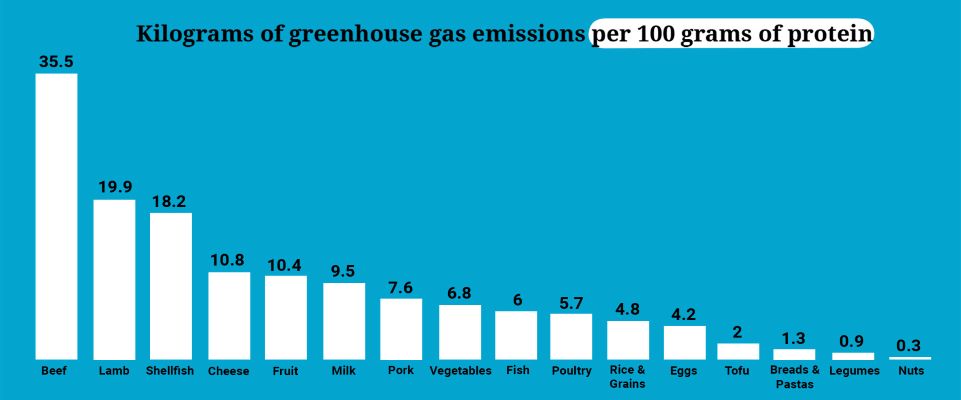Red Meat Production at Risk Over Climate-Induced Dangers
New research indicates that cattle farming will become less viable in the years to come if carbon emissions remain high and temperatures keep rising.
According to a study published in the IOPScience journal more than 1 billion cows around the world will experience heat stress by the end of the century.
When combined with humidity extreme heat is harmful to livestock, particularly cattle; reducing fertility, impairing growth, lowering milk production and increasing mortality rates.
Researchers from the Universities of Cape Town, KwaZulu-Natal and Chicago analysed today’s heat and humidity conditions around the world, projecting that if future carbon emissions are very high the majority of cows will be experiencing more heat-related ailments as global warming intensifies.
Today’s decisions in our dietary preferences will be critical for the coming years. Reducing the amount of beef intake and eating more plant-based products would be key in rapidly cutting carbon emissions. Climate change has already demonstrated the significant and deadly effects it will have for humans, but so too for the animals that are a part of the agricultural food system.
About a third of all human-caused greenhouse gas emissions is linked to the food we eat. Most food-related greenhouse gases today is as a result of methane from cattle’s digestive processes, nitrous oxide from fertilisers used for crop production and carbon dioxide from cutting down forests for the expansion of farmland, As a result animal-based foods, especially red meat, are generally associated with the highest greenhouse gas emissions.
Diet Change for Climate Change
According to the United Nations Climate Action, plant-based foods use less energy, land, and water, and have lower greenhouse gas intensity than animal-based foods. Red meat and in particular cattle farming produces carbon emissions that are orders of magnitude higher than even the combined emissions of grains, legumes, nuts and other plant-based outputs.
Here are two charts by the United Nations showing the carbon footprint of different food items:
Plant-based meat alternatives such as The Beyond Burger also have a significantly lower environmental footprint than the production of a typical beef burger. A peer-reviewed study conducted by the University of Michigan quantified the impact, and by comparison it requires 99% less water, 93% less land, nearly 50% less energy and produces 90% fewer greenhouse gas emissions.
Beans, pulses and legumes are some of the most carbon-efficient, low resource-use agricultural food products available and present a simple solution to effectively combating climate change.
According to Pulses.org, “When pulses are grown, they use 1/2 to 1/10 the water of other sources of protein. Many pulse crops are adapted to dry environments, making them well-suited for areas that are prone to drought.”
“When soil is fertilised with nitrogen in the form of manure, fertiliser, or crop residue, soil microorganisms convert some of this nitrogen into nitrous oxide, which is a powerful greenhouse gas. Nitrous oxide is 300 times more potent than carbon dioxide (CO2) and represents around 46% of the greenhouse gas emissions from global agriculture.”
“Since greenhouse gas emissions related to crop production are largely driven by nitrogen fertilisers, nitrogen-fixing pulse crops have a lower carbon footprint compared to other crops.”
One international campaign, named Beans is How, aims to double the global consumption of beans, peas, lentils and other pulses by 2028.
Their projects seek to demonstrate the importance of beans as an affordable solution to the health and environmental challenges of today. Beans reduce the need for synthetic fertilisers by converting atmospheric nitrogen into a plant-usable form while using less water than many other crops and offering rich protein, dietary fibre, a variety of micronutrients and being low in fat.
Studies by the Harvard School of Public Health have shown that the intake of red meat and processed meat is associated with an increased risk for diabetes, heart disease and a range of cancers; emphasising the potential dangers and the related health-care costs of eating these products. Furthermore, cattle farming is a multi-layered threat that wreaks environmental havoc and is ultimately harmful to the livestock themselves – not to mention farm productivity, thus increasing food costs – due to the impacts of the resulting warmer climate.
Clearly there is a strong causal link between red meat production and a rise in global temperatures, and according to the Washington Post 2023 is set to be the hottest year on record.
Says Donovan Will, director of ProVeg South Africa, “The best way to protect animals is to reduce the demand for them to be farmed in the first place by eating more plant-based foods.”
Diminishing our reliance on animal products, especially beef, and growing the market for plant-based proteins is a clear route to addressing this major source of climate change emissions and lessening the correlated stresses placed on animals, both agricultural and otherwise.









